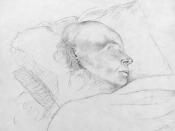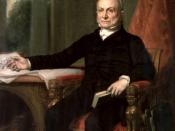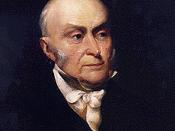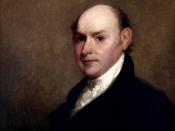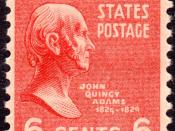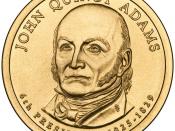Presidential Outline I. John Quincy Adams A. Born- July 11, 1767 B. Died- February 23, 1828 II. Background A. Educational- Attended Harvard (1785-1787); Studied law under Theophilus Parsons at Newburyport, Mass. (1787-1790); Admitted to the bar, 1790.
B. Occupational- 1. Minister to the Netherlands, 1784-1797 2. Minister to Prussia, 1797-1801 3. Massachusetts State Senator, 1802 4. US Senator (Federalist-Massachusetts), 1803-1808 5. Minister to Russia, 1809-1814 6. Chief Negotiator of Treaty of Ghent, 1814 7. Minister to Great Britain, 1815-1825 8. Secretary of State, 1817-1825 (under James Monroe) III. Terms Of Office A. First Term (1825-1829) IV. Prominent Issues of the Election A. Varied degrees of support for a protective tariff B. A federal program of internal improvements V. Opponents A. First Term- 1. Andrew Jackson, Tennessee 2. William H. Crawford, Georgia 3. Henry Clay, Kentucky VI. Vice Presidents A. First Term- John C. Calhoun, South Carolina VII. Political Party- no party labels used VIII.
Domestic Events A. John Quincy Adams becomes the 6th President, 1825.
B. Erie Canal Opens, 1825: links Lake Erie with New York City through the Hudson River.
C. South Carolina Exposition and Protest, 1828: after an anti-tariff protest was held in Columbia, South Carolina, delegates from 13 states convened to urge a tariff rise, following the denial of a bill concerning tariff increases, after a tie-breaking vote from Vice-President Calhoun.
IX. Major Foreign Policy A. Panama Congress, 1826: Adams supported US participation in the Panama Congress; However, southern congressmen who feared the meeting might be used to condemn slavery, as well as Adams's political opponents delayed the confirmation of the US delegates long enough to make it impossible to reach Ranama in time to attend.
B. Tariff of Abominations, 1828: A high tariff on imported manufactured goods to protect domestic industry. Later prompted Vice President Calhoun to draft the SC Exposition condemning the tariff as "unconstitutional, oppressive, and unjust"ÃÂ and claiming the right of a state to nullify such laws.
X. Major Conflict A. The Tariff of Abominations proved Adams's reluctancy to submit to political pressures and helped to instill a certain sense of confidence and purpose into the government.
XI. Major Inventions and Technological Advancements A. Noah Webster Publishes Dictionary, 1828: publication of the first American Dictionary of the English Language, by Noah Webster, contains two volumes and over 38,000 entries.
XII. Major Social Changes A. Works Begin on Baltimore and Ohio Railroad, 1828.
XIII. Overall rating of the President
